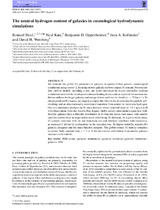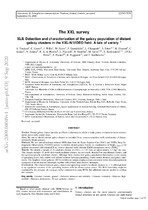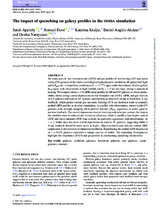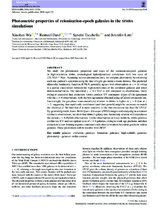The neutral hydrogen content of galaxies in cosmological hydrodynamic simulations
Date
2013Author
Dave, Romeel
Katz, Neal
Oppenheimer, Benjamin D.
Kollmeier, Juna A.
Weinberg, David H.
Metadata
Show full item recordAbstract
We examine the global HI properties of galaxies in quarter billion particle cosmological
simulations using GADGET-2, focusing on howgalactic outflows impactHI content.We consider
four outflow models, including a new one (ezw) motivated by recent interstellar medium
simulations in which the wind speed and mass loading factor scale as expected for momentumdriven
outflows for larger galaxies and energy-driven outflows for dwarfs (σ <75 km s−1). To
obtain predicted HI masses, we employ a simple but effective local correction for particle selfshielding
and an observationally constrained transition from neutral to molecular hydrogen.
Our ezw simulation produces an HI mass function whose faint-end slope of −1.3 agrees well
with observations from the Arecibo Fast Legacy ALFA survey; other models agree less well.
Satellite galaxies have a bimodal distribution in HI fraction versus halo mass, with smaller
satellites and/or those in larger haloes more often being HI deficient. At a given stellar mass,
HI content correlates with the star formation rate and inversely correlates with metallicity,
as expected if driven by stochasticity in the accretion rate. To higher redshifts, massive HI
galaxies disappear and the mass function steepens. The global cosmic HI density conspires
to remain fairly constant from z ∼ 5→0, but the relative contribution from smaller galaxies
increases with redshift.
Collections
Related items
Showing items related by title, author, creator and subject.
-
The XXL survey XLII. Detection and characterization of the galaxy population of distant galaxy clusters in the XXL-N/VIDEO field: A tale of variety
Jarvis, M.; Trudeau, A.; Garrel, C. (ESO, 2020)Context. Distant galaxy clusters provide an effective laboratory in which to study galaxy evolution in dense environments and at early cosmic times. Aims. We aim to identify distant galaxy clusters as extended X-ray sources ... -
The impact of quenching on galaxy profiles in the SIMBA simulation
Dave, Romeel; Appleby, Sarah; Kraljic, Katarina (Oxford University Press, 2020)We study specific star formation rate (sSFR) and gas profiles of star-forming (SF) and green valley (GV) galaxies in the SIMBA cosmological hydrodynamic simulation. SF galaxy half-light radii (Rhalf) at z = 0 and their ... -
Photometric properties of reionization-epoch galaxies in the SIMBA simulations
Dave, Romeel; Wu, Xiaohan; Tacchella, Sandro (Oxford University Press, 2020)We study the photometric properties and sizes of the reionization-epoch galaxies in high-resolution SIMBA cosmological hydrodynamical simulations with box sizes of [25,50]h−1Mpc. Assuming various attenuation laws, we ...




